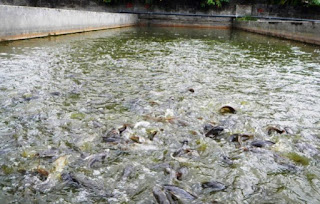Unit of Life in the Ecosystem's Biotic Component
Components of the
ecosystem composed of living things (biotic) and non-living creatures
(abiotik). For example, the wetland ecosystem is composed of various types of
animals and plants. They live together and interact with each other through an
interaction pattern. Well, this pattern of interaction can occur in units of
life in various ecosystems, be they individual units, populations, communities,
ecosystems themselves, biomes, and biosphere.
1. Individuals
Unit of Life in the
Ecosystem's Biotic Component
Have you ever seen a
goat or a goose or a coconut tree? A goat or a goose is called an individual.
Similarly with a coconut tree. The individual is the smallest living unit,
composed of himself. Even you yourself also include individual units. Well, now
can you mention other individuals around your residence?
2. Population

A set of goats in a
cage called a goat population. A collection of catfish in the pond called
catfish population. If the pool is also overgrown with a lotus, then in the
pond there is also a lotus population.
The population of catfish
in the pond ecosystem
The population of
catfish in the pond
The same set of
individuals forms the population. The population is a group of similar
individuals living in a particular habitat. From the above example, can you
name other population samples?
Population density is
the number or size of a large unity population. For example, the density of the
oil palm population is 142 trees per hectare, or the silkworm population
density is 20 caterpillars per m2.
Population change is a
change in the number of individual units in a population that is in one unit
area and lasts for a certain period of time. Population changes can occur due
to immigration and emigration.
Immigration is the
population increase caused by birth (natalitas) and migrants from other places,
emigration is the
reduced population caused by the death (mortality) and the departure of
individuals to another place.
3. Community
Consider the fish pond
in your house! Inside the fish pond, there will be a collection of catfish, a
collection of lotus, a collection of algae, and a collection of frogs. Well, a
collection of the population that lives in the pond water is called the pool
community.
The community is a
collection of diverse populations of living things that live in a particular
habitat. A community is composed of all living populations and interacts with
each other in a particular habitat and time.
4. Ecosystems
The catfish community is
always associated with dead creatures in ponds that include water, soil, air,
and sunlight. The community can not be separated from the influence of the
surrounding environment. Between communities and the environment interact and
form an ecological system known as ecosystem.
An ecosystem is a unity
of communities and the environment that interact with each other and form a
continuous reciprocal relationship. Therefore, ecosystems are also called
environmental systems (ecological systems).
5. Biomes
Ecosystems have
different sizes. Small ecosystems will form larger ecosystems. All of the
ecosystems on earth will form a larger ecosystem called biomes, for example
desert biomes.
6. Biosphere
The biosphere is the
outer part of the planet earth that includes land, air, and water, as a place
of life takes place. In the sense of geophysiology, the biosphere can be
defined as a global ecological system that unifies all living things and their
interactions between each other or their interactions with their environment.
Biosphere can also be interpreted as a collection of biomes.
Now that's the
explanation of some life units in the ecosystem component. For more details,
please see the illustration on the pyramid picture above ya!


0 Response to "Unit of Life in the Ecosystem's Biotic Component"
Post a Comment